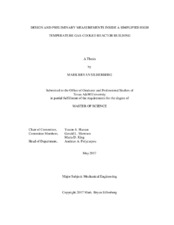| dc.contributor.advisor | Hassan, Yassin A | |
| dc.creator | Silberberg, Mark Bryan | |
| dc.date.accessioned | 2017-08-21T14:36:37Z | |
| dc.date.available | 2019-05-01T06:09:37Z | |
| dc.date.created | 2017-05 | |
| dc.date.issued | 2017-04-28 | |
| dc.date.submitted | May 2017 | |
| dc.identifier.uri | https://hdl.handle.net/1969.1/161400 | |
| dc.description.abstract | A simplified high temperature gas-cooled reactor building was developed at Texas A&M University to understand the response of an actual facility to a depressurization accident scenario. A set of scaling laws were established to preserve the major flow phenomena and the geometry of the facility was simplified to focus on characterizing the key phenomena that determine the reactor building atmospheric concentration over time without the complexity of modeling the detailed features of an actual reactor building. The facility was outfitted with several instruments to measure localized oxygen concertation, pressure and temperature with the flexibility for the addition of measurement devices for future testing.
The design of the facility required computing the leak rate scaled to the amount of air leaked from the prototype facility in one day. After determining the target leak rate the facility leak paths were acclimated to allow for air to leak from the facility. This was achieved by adjusting a set of needle valves at select locations on the simplified facility. Comparison of the achieved leak rate with an analytical fit to the model was shown to have a high degree of statistical similitude from determination of the R^2 values. The analytical model was determined by assuming the helium and air inside the faculty behave as an ideal gas. Finally, several tests were conducted to characterize the phenomena for a sudden depressurization inside of the simplified test facility. The velocity in the flow path connecting two adjoining test volumes was determined from the response of the oxygen probes to air intrusion into the facility.
Finally, PIV measurements were conducted to analyze a helium buoyant jet flowing through a check valve that operates at 1 psid. Temporal resolution of the velocity field displayed erratic behavior in the region downstream of the inlet near the steam generator wall and was suspected to be from the development of flow instabilities from the difference in density between the helium jet and air. Entrainment effects were hypothesized to have occurred due to Rayleigh-Taylor instabilities that resulted in the development of vortical structures and local acceleration of the flow field. | en |
| dc.format.mimetype | application/pdf | |
| dc.language.iso | en | |
| dc.subject | High Temperature Gas-Cooled Reactor | en |
| dc.subject | PIV | en |
| dc.subject | NGNP | en |
| dc.title | Design and Preliminary Measurements Inside a Simplified High Temperature Gas-Cooled Reactor Building | en |
| dc.type | Thesis | en |
| thesis.degree.department | Mechanical Engineering | en |
| thesis.degree.discipline | Mechanical Engineering | en |
| thesis.degree.grantor | Texas A & M University | en |
| thesis.degree.name | Master of Science | en |
| thesis.degree.level | Masters | en |
| dc.contributor.committeeMember | Morrison, Gerald L | |
| dc.contributor.committeeMember | King, Maria D | |
| dc.type.material | text | en |
| dc.date.updated | 2017-08-21T14:36:37Z | |
| local.embargo.terms | 2019-05-01 | |
| local.etdauthor.orcid | 0000-0001-8788-8521 | |


